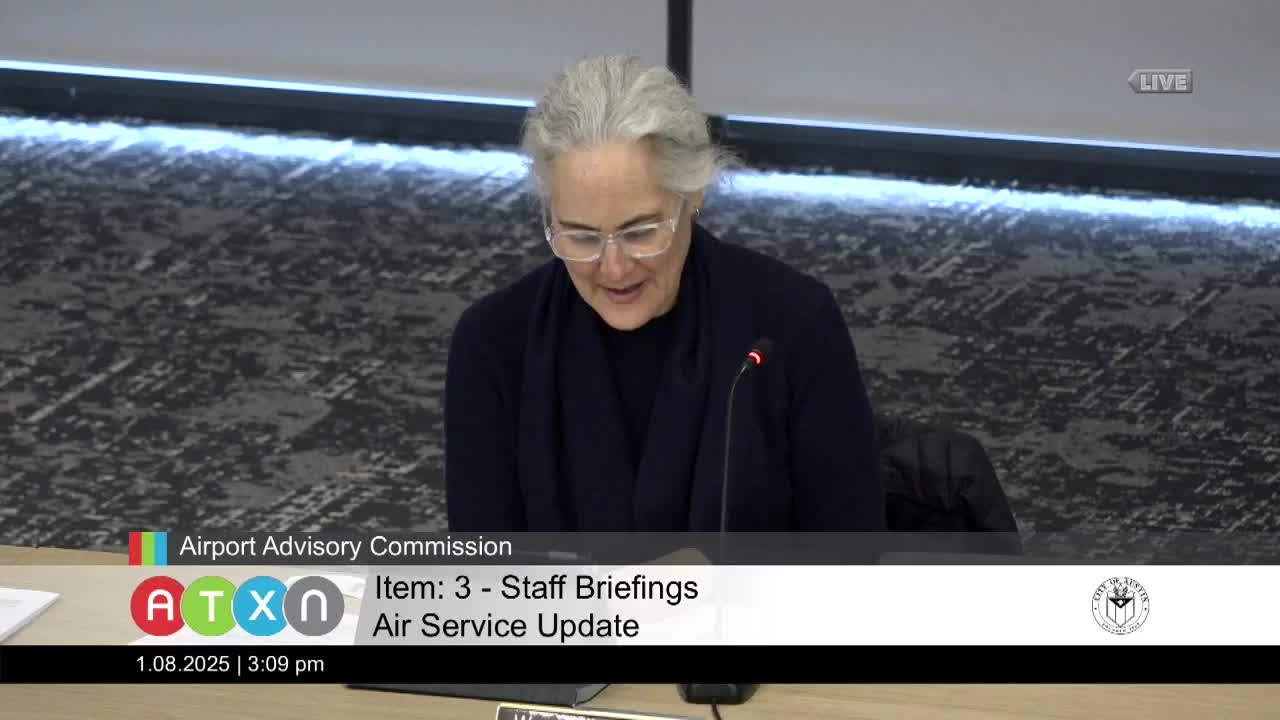Consultant: Austin remains robust vs. 2019 but airline shifts and aircraft delays are reshaping schedules
January 08, 2025 | Austin, Travis County, Texas
This article was created by AI summarizing key points discussed. AI makes mistakes, so for full details and context, please refer to the video of the full meeting. Please report any errors so we can fix them. Report an error »

Jamie Kazanoff, air service manager, and Kevin Shore, vice president at Campbell Hill Aviation Group, presented the airport’s January air‑service report and a detailed market briefing.
Jamie said the report now compares quarterly seat capacity to 2019 and noted Q1 2025 seat capacity is roughly flat year‑over‑year but materially higher than pre‑COVID 2019 in aggregate. She highlighted carriers that have added or changed service, including Air Canada (additional summer frequency and seasonal Montreal), WestJet (new Vancouver nonstop), Delta (multiple new domestic and special‑event services), Southwest (new year‑round route to Milwaukee and new options to San Francisco), Frontier (new ultra‑low‑cost routes), and the planned second daily British Airways frequency starting March 29, 2025. Jamie also noted Hawaiian’s last day in Austin is scheduled for March 26, 2025 because Alaska (which acquired Hawaiian) is reallocating wide‑body aircraft.
Kevin Shore described how airlines make route decisions — using DOT O&D and T‑100 data, load factors, local demand and demographics, aircraft availability, seasonality and schedule‑day economics. He emphasized aircraft delivery delays and labor costs as current constraints: "For 2024, we saw about 46% fewer deliveries than airlines expected — they expected ~543 and received ~283," Shore said, and added that those shortages limit an airline's ability to add service.
Shore also reviewed Austin‑specific metrics: capacity for Q1 2025 is up roughly 34% versus Q1 2019 and Q2 2025 capacity is up about 37% versus the same 2019 quarter. Year‑over‑year comparisons show an American Airlines reduction in capacity (American down ~27% Q1 2025 vs Q1 2024) but significant additions from carriers such as Delta and Frontier. He summarized the airport’s air service objectives: maintain existing routes, pursue near‑international and long‑haul international markets (including Asia and South America), extend seasons and increase frequencies where viable, and coordinate with local economic and tourism partners.
In question and answer, commissioners asked what civic stakeholders could do to attract nonstop service to Asia. Shore said the critical items are aircraft availability, joint‑venture alignment with U.S. partners for Asian carriers, and community data that demonstrates business and VFR (visiting friends and relatives) demand; he praised collaboration with Opportunity Austin, the chambers and VISIT Austin for supplying market data.
Commissioners also asked whether the new terminal would affect airline decisions; Shore said the new terminal should provide schedule flexibility and capacity that could enable new domestic and international offerings and give airlines the ability to add frequencies and new carriers at desirable times of day.
Jamie said the report now compares quarterly seat capacity to 2019 and noted Q1 2025 seat capacity is roughly flat year‑over‑year but materially higher than pre‑COVID 2019 in aggregate. She highlighted carriers that have added or changed service, including Air Canada (additional summer frequency and seasonal Montreal), WestJet (new Vancouver nonstop), Delta (multiple new domestic and special‑event services), Southwest (new year‑round route to Milwaukee and new options to San Francisco), Frontier (new ultra‑low‑cost routes), and the planned second daily British Airways frequency starting March 29, 2025. Jamie also noted Hawaiian’s last day in Austin is scheduled for March 26, 2025 because Alaska (which acquired Hawaiian) is reallocating wide‑body aircraft.
Kevin Shore described how airlines make route decisions — using DOT O&D and T‑100 data, load factors, local demand and demographics, aircraft availability, seasonality and schedule‑day economics. He emphasized aircraft delivery delays and labor costs as current constraints: "For 2024, we saw about 46% fewer deliveries than airlines expected — they expected ~543 and received ~283," Shore said, and added that those shortages limit an airline's ability to add service.
Shore also reviewed Austin‑specific metrics: capacity for Q1 2025 is up roughly 34% versus Q1 2019 and Q2 2025 capacity is up about 37% versus the same 2019 quarter. Year‑over‑year comparisons show an American Airlines reduction in capacity (American down ~27% Q1 2025 vs Q1 2024) but significant additions from carriers such as Delta and Frontier. He summarized the airport’s air service objectives: maintain existing routes, pursue near‑international and long‑haul international markets (including Asia and South America), extend seasons and increase frequencies where viable, and coordinate with local economic and tourism partners.
In question and answer, commissioners asked what civic stakeholders could do to attract nonstop service to Asia. Shore said the critical items are aircraft availability, joint‑venture alignment with U.S. partners for Asian carriers, and community data that demonstrates business and VFR (visiting friends and relatives) demand; he praised collaboration with Opportunity Austin, the chambers and VISIT Austin for supplying market data.
Commissioners also asked whether the new terminal would affect airline decisions; Shore said the new terminal should provide schedule flexibility and capacity that could enable new domestic and international offerings and give airlines the ability to add frequencies and new carriers at desirable times of day.
View full meeting
This article is based on a recent meeting—watch the full video and explore the complete transcript for deeper insights into the discussion.
View full meeting
